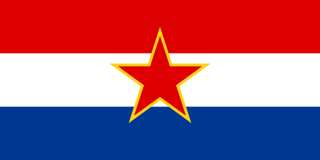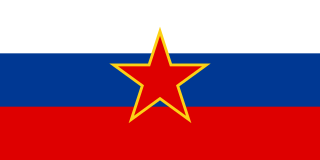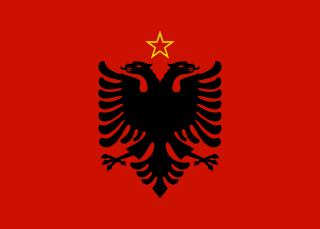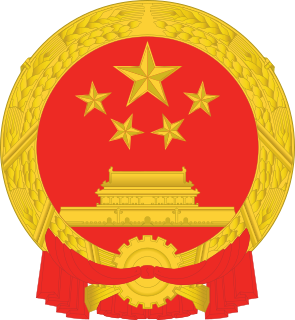
The Socialist Party of Serbia is a left-wing populist political party in Serbia that identifies as democratic socialist and social-democratic. The Socialist Party of Serbia was the direct descendant of the League of Communists of Serbia. Throughout its existence, the party has utilised some nationalist rhetoric and themes, and has therefore been labelled a Serbian nationalist party, although the SPS has never identified itself as such.

A red star, five-pointed and filled, is an important symbol that has often historically been associated with communist ideology, particularly in combination with the hammer and sickle, but is also used as a purely socialist symbol in the 21st century. It has been widely used in flags, state emblems, monuments, ornaments, and logos. Red Star is also Alexander Bogdanov's 1908 science fiction novel about a communist society on Mars.

Milovan Đilas was a Yugoslav communist politician, theorist and author. He was a key figure in the Partisan movement during World War II, as well as in the post-war government. A self-identified democratic socialist, Đilas became one of the best-known and most prominent dissidents in Yugoslavia and all of Eastern Europe.
Thomas Hodgskin was an English socialist writer on political economy, critic of capitalism and defender of free trade and early trade unions. In the late 19th and early 20th centuries, the term socialist included any opponent of capitalism, at the time defined as a construed political system built on privileges for the owners of capital.

The Socialist Republic of Croatia was a constituent republic and federated state of Yugoslavia and the nation state of Croats. By its constitution, modern-day Croatia is its direct continuation.
Predrag Vranicki was a Marxist Humanist and member of the Praxis school in the 1960s in Yugoslavia.

The Praxis school was a Marxist humanist philosophical movement, whose members were influenced by Western Marxism. It originated in Zagreb and Belgrade in the SFR Yugoslavia, during the 1960s.

The Socialist Republic of Bosnia and Herzegovina, commonly referred to as Socialist Bosnia or simply Bosnia, was one of the six constituent federal states forming the Socialist Federal Republic of Yugoslavia. It was a predecessor of the modern-day Bosnia and Herzegovina, existing between 1945 and 1992, under a number of different formal names, including Democratic Bosnia and Herzegovina (1943–1946) and People's Republic of Bosnia and Herzegovina (1946–1964).

The Socialist Republic of Serbia, previously known as Federal State of Serbia and People's Republic of Serbia, commonly referred to as Socialist Serbia, or simply as Serbia, was one of the six constituent republics of the Socialist Federal Republic of Yugoslavia and the nation state of the Serbs. It was the largest constituent republic in terms of population and territory. Its capital, Belgrade, was also the federal capital of Yugoslavia.
Music of Yugoslavia was the music of Yugoslavia.

The Socialist Republic of Slovenia, commonly referred to as Socialist Slovenia or simply Slovenia, was one of the six federal republics forming the post-World War II country of Yugoslavia and the nation state of the Slovenes. It existed under various names from its creation on 29 November 1945 until 25 June 1991. In 1990, while the country was still a part of the Yugoslav federation, the League of Communists of Slovenia allowed for the establishment of other political parties, which led to the democratization of the country.

Albania, officially the People's Socialist Republic of Albania, was ruled by a Marxist-Leninist government from 1946 to 1992. From 1944 to 1946, it was known as the Democratic Government of Albania and from 1946 to 1976 it was known as the People's Republic of Albania.

Socialist heraldry, also called communist heraldry, consists of emblems in a style typically adopted by socialist states and filled with communist symbolism. Although commonly called coats of arms, most such devices are not actually coats of arms in the heraldic sense and should therefore not be called arms at all. Many communist governments purposely diverged from the traditional forms of European heraldry in order to distance themselves from the monarchies that they usually replaced, with actual coats of arms being seen as symbols of the monarchs.

Architecture of North Macedonia refers to architecture ever practised on the territory of present-day North Macedonia.

Architecture of Belgrade refers to the architecture and styles developed in Belgrade, Serbia. Belgrade has wildly varying architecture, from the centre of Zemun, typical of a Central European town, to the more modern architecture and spacious layout of New Belgrade. The oldest architecture is found in Kalemegdan park. Outside of Kalemegdan, the oldest buildings date only from 19th century, due to its geographic position and frequent wars and destructions. The oldest public structure in Belgrade is a nondescript Turkish türbe, while the oldest house is a modest clay house on Dorcol, the House at 10 Cara Dušana Street from 1727.
Yugoslav Action was a radical Yugoslav nationalist organization that supported an authoritarian corporatist system and a planned economy, active between 1930 and 1935. During its existence it was the most radical Yugoslavist group. The movement was founded on 7 January 1930 in Belgrade, but was based in both Belgrade and Zagreb, although mainly developed in Croatia. The movement supported King Alexander's royal dictatorship. The organization was claimed by others to be fascist, though the party itself denied this. It has been described as one of three notable fascist movements, the other being the Association of Fighters of Yugoslavia and the Yugoslav National Movement, that emerged in Yugoslavia in the 1930s, all of whom supported the monarchy, and would reach their zenith during the Axis occupation of Yugoslavia (1941–45). The organization adopted symbols imitating the NSDAP, such as a blue swastika and a raised right hand. It was merged along with other organizations, such as Boj ("Battle") in Slovenia, and groups surrounding the magazines of Zbor ("Council") and Otadžbina ("Homeland") based in Belgrade, and Budjenje ("Awakening") in Zrenjanin, to form the Yugoslav National Movement led by Dimitrije Ljotić in early 1935. The core of the Yugoslav National Movement, also known as "Zbor", was recruited from Yugoslav Action. Zbor played no significant role prior to the German occupation; afterwards, however, it was among the main supporters of the Nazi military administration.

Džuboks was a Yugoslav music magazine. Founded in 1966, it was the first magazine in SFR Yugoslavia dedicated predominantly to rock music, and the first rock music magazine to be published in a communist country.

The Socialist Autonomous Province of Kosovo, comprising the Kosovo region, was one of the two autonomous provinces of Serbia within Yugoslavia, between 1945 and 1990, when it was renamed Autonomous Province of Kosovo and Metohija.
The Association of Fighters of Yugoslavia, known as Boj, was a Yugoslav nationalist organization in the Drava Banovina (Slovenia) of the Kingdom of Yugoslavia, active between 1930 and 1935. It was established in 1929 as the Union of Slovene Soldiers, then renamed in 1930 to Union of Fighters. The movement supported King Alexander's royal dictatorship. It was approved by the Drava Banovina administration in 1931. In late 1933, the organization was renamed as the "Association of Fighters of Yugoslavia". It was merged along with other organizations, such as Yugoslav Action that was based mainly in Croatia, and groups surrounding the magazines of Zbor ("Council") and Otadžbina ("Homeland") based in Belgrade, and Budjenje ("Awakening") in Zrenjanin, to form the Yugoslav National Movement led by Dimitrije Ljotić in early 1935.

The architecture of Yugoslavia was characterized by emerging, unique, and often differing national and regional narratives. As a socialist state remaining free from the Iron Curtain, Yugoslavia adopted a hybrid identity that combined the architectural, cultural, and political leanings of both Western liberal democracy and Soviet communism.














